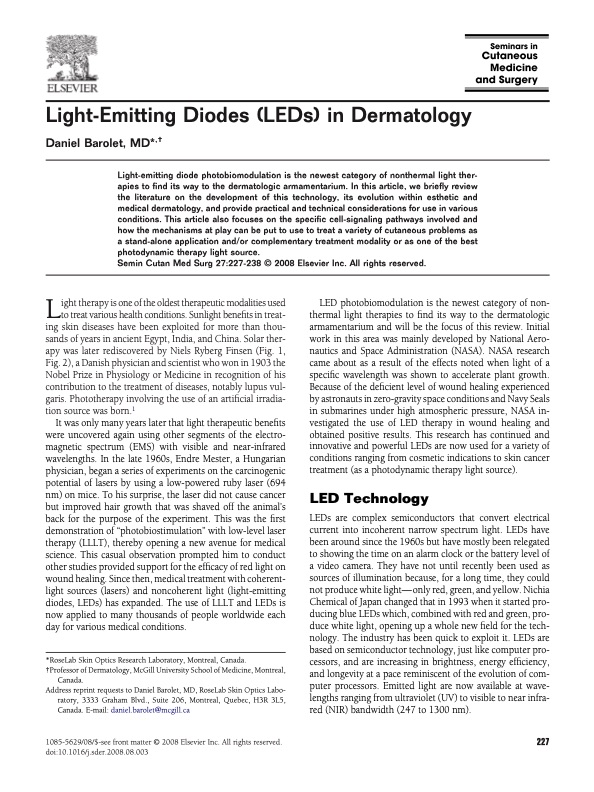
PDF Publication Title:
Text from PDF Page: 001
Light-Emitting Diodes (LEDs) in Dermatology Daniel Barolet, MD*,† Light-emitting diode photobiomodulation is the newest category of nonthermal light ther- apies to find its way to the dermatologic armamentarium. In this article, we briefly review the literature on the development of this technology, its evolution within esthetic and medical dermatology, and provide practical and technical considerations for use in various conditions. This article also focuses on the specific cell-signaling pathways involved and how the mechanisms at play can be put to use to treat a variety of cutaneous problems as a stand-alone application and/or complementary treatment modality or as one of the best photodynamic therapy light source. Semin Cutan Med Surg 27:227-238 © 2008 Elsevier Inc. All rights reserved. Light therapy is one of the oldest therapeutic modalities used to treat various health conditions. Sunlight benefits in treat- ing skin diseases have been exploited for more than thou- sands of years in ancient Egypt, India, and China. Solar ther- apy was later rediscovered by Niels Ryberg Finsen (Fig. 1, Fig. 2), a Danish physician and scientist who won in 1903 the Nobel Prize in Physiology or Medicine in recognition of his contribution to the treatment of diseases, notably lupus vul- garis. Phototherapy involving the use of an artificial irradia- tion source was born.1 It was only many years later that light therapeutic benefits were uncovered again using other segments of the electro- magnetic spectrum (EMS) with visible and near-infrared wavelengths. In the late 1960s, Endre Mester, a Hungarian physician, began a series of experiments on the carcinogenic potential of lasers by using a low-powered ruby laser (694 nm) on mice. To his surprise, the laser did not cause cancer but improved hair growth that was shaved off the animal’s back for the purpose of the experiment. This was the first demonstration of “photobiostimulation” with low-level laser therapy (LLLT), thereby opening a new avenue for medical science. This casual observation prompted him to conduct other studies provided support for the efficacy of red light on wound healing. Since then, medical treatment with coherent- light sources (lasers) and noncoherent light (light-emitting diodes, LEDs) has expanded. The use of LLLT and LEDs is now applied to many thousands of people worldwide each day for various medical conditions. *RoseLab Skin Optics Research Laboratory, Montreal, Canada. †Professor of Dermatology, McGill University School of Medicine, Montreal, Canada. Address reprint requests to Daniel Barolet, MD, RoseLab Skin Optics Labo- ratory, 3333 Graham Blvd., Suite 206, Montreal, Quebec, H3R 3L5, Canada. E-mail: daniel.barolet@mcgill.ca 1085-5629/08/$-see front matter © 2008 Elsevier Inc. All rights reserved. doi:10.1016/j.sder.2008.08.003 LED photobiomodulation is the newest category of non- thermal light therapies to find its way to the dermatologic armamentarium and will be the focus of this review. Initial work in this area was mainly developed by National Aero- nautics and Space Administration (NASA). NASA research came about as a result of the effects noted when light of a specific wavelength was shown to accelerate plant growth. Because of the deficient level of wound healing experienced by astronauts in zero-gravity space conditions and Navy Seals in submarines under high atmospheric pressure, NASA in- vestigated the use of LED therapy in wound healing and obtained positive results. This research has continued and innovative and powerful LEDs are now used for a variety of conditions ranging from cosmetic indications to skin cancer treatment (as a photodynamic therapy light source). LED Technology LEDs are complex semiconductors that convert electrical current into incoherent narrow spectrum light. LEDs have been around since the 1960s but have mostly been relegated to showing the time on an alarm clock or the battery level of a video camera. They have not until recently been used as sources of illumination because, for a long time, they could not produce white light— only red, green, and yellow. Nichia Chemical of Japan changed that in 1993 when it started pro- ducing blue LEDs which, combined with red and green, pro- duce white light, opening up a whole new field for the tech- nology. The industry has been quick to exploit it. LEDs are based on semiconductor technology, just like computer pro- cessors, and are increasing in brightness, energy efficiency, and longevity at a pace reminiscent of the evolution of com- puter processors. Emitted light are now available at wave- lengths ranging from ultraviolet (UV) to visible to near infra- red (NIR) bandwidth (247 to 1300 nm). 227PDF Image | (LEDs) in Dermatology

PDF Search Title:
(LEDs) in DermatologyOriginal File Name Searched:
vol27_i4_Light-Emitting_Diodes.pdfDIY PDF Search: Google It | Yahoo | Bing
Cruise Ship Reviews | Luxury Resort | Jet | Yacht | and Travel Tech More Info
Cruising Review Topics and Articles More Info
Software based on Filemaker for the travel industry More Info
The Burgenstock Resort: Reviews on CruisingReview website... More Info
Resort Reviews: World Class resorts... More Info
The Riffelalp Resort: Reviews on CruisingReview website... More Info
| CONTACT TEL: 608-238-6001 Email: greg@cruisingreview.com | RSS | AMP |